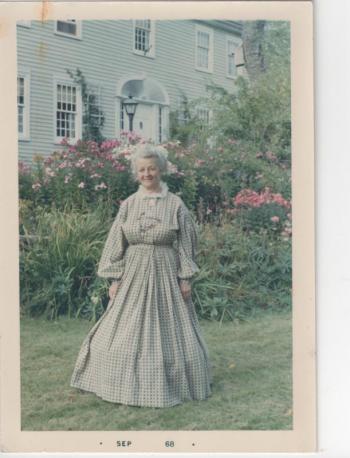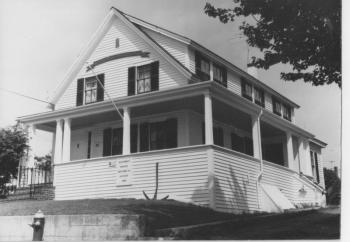50 Years of Local History
Before the present Boothbay Region Historical Society was founded in 1967, there were earlier attempts to create a space dedicated to local history and curios. I learned about a couple of them in old newspapers.
Early Museums and Historical Groups
In the 1870s, Daniel Sawyer started exhibiting curios and local artifacts in Boothbay's custom house in present day Boothbay Harbor. After Sawyer's 1892 death, George Kenniston continued the little public museum, perhaps in his law office. The Register reported on the holdings about six times a year to inform townspeople of new items. I have no idea when it was discontinued or what became of its artifacts.
Next, a local historical society was loosely formed in 1919. Francis Greene, the author of a 1906 town history, and Elizabeth F. Reed, an ardent and expert local historian, were the key individuals involved, along with a number of others. The activities of the society were almost exclusively lectures and pageants on historical topics in private homes during the summer. Elizabeth Reed could then leave her teaching duties in New York City to spend her summer in Boothbay Harbor. In July 1925 an attempt to formalize the group, mark historic sites, and collect relics took place. The society held meetings for a few years, but it was not to endure and if relics were acquired, they were scattered again, as those gathered in the 1800s had been. I have searched for any in Wiscasset and Portland repositories.
Our Formation
On November 7, 1967 the first of weekly meetings of interested residents to consider forming the present Boothbay Region Historical Society was held at the Chamber of Commerce rooms in the Harbor's town office on McKown Street. At the next meeting a proposal came up to rent part of the Carlisle house on Union Street. The group dropped the idea the following week and got back to the nuts and bolts of formally organizing. By late November, local lawyer Asa Tupper Sr. had donated his time to draw up by-laws; incorporate the society; and obtain a seal, a metal embosser which we still have.
On November 30, 1967 at a publicized meeting, 32 members of the public nominated and elected the first board of trustees: Chester Swett, Cecil Pierce, Jim Stevens, Jack Dorr, Sidney Baldwin, Harold Clifford, Walter Jacobs, Pat Jackson, and Donald Orne. Of those founding trustees, Cecil Pierce and Jim Stevens continued as board members to their 1996 and 2002 deaths respectively. Memberships were also accepted, but the membership cards had to wait until designed and printed in January. By January 16, 1968 there were 42 "charter" members, including my parents.
For a few years after I got involved in 1986, multiple individuals came up to me to say, "I really started the historical society." They each mentioned their role in suggesting to various people that a historical society would be a good thing—but such talk is easy. Probably some fraction of the inhabitants in every town without a society talk about creating one, but the credit properly belongs to those true workers who put in the hard time and energy to bring such an organization into being.
Early Exhibit Spaces
The first 1968 exhibit space was seasonal, June to September, in the barn of the 1768 Nicholas Knight house at Boothbay Center. It was then the home of two of the early trustees, P. Wentworth and Birdene Webster Shackleton. It may be that the key to the survival of the society lies in its responsibility for a rented or owned space and ownership of the artifacts to be displayed. The 1919 local society had few artifacts and no space, no compelling reason to hold itself together, no matter what the circumstances. Perhaps to be burdened with physical objects creates a stronger sense of commitment.
In March 1972 the society moved to downtown Boothbay Harbor, renting the Hyde House which was owned by the Boothbay Harbor Memorial Library. Though business meetings were held there year-round in the early 1970s, the uncertain furnace finally necessitated a seasonal occupation and the Harbor town lounge on McKown Street was often the meeting place. During the summer there were regular reports in the Register of artifact gifts and visitors.
Permanent homes for the society were continually investigated. The old lobster factory/boathouse at Lobster Cove's Barrett Park (now gone) looked like a satisfactory home, but it didn't happen. When the Shackletons decided to sell the Knight house at the Center, that site was considered. The Clisby property (now gone) on Howard Street was looked into, and a site at the head of Boothbay Harbor appeared to be a likely prospect in 1981. None of those opportunities worked out, most often because the expense was daunting.
Into the 1980s
After I'd been involved for a few years, both Cecil Pierce and Jim Stevens told me that the board repeatedly discussed giving up and disbanding. I think perhaps the arrival of Bea Walker, Alden Stickney, and Stan and Jean Chenoweth as trustees in the early 1980s, who were in place when I came on in 1986, heartened the board members to persevere. Alden and Bea continued about 20 years as committed, hard-working trustees, until 2003.
Finally in 1984 the society moved to its present location through the efforts of its then-president Bea Walker. For 33 years the town of Boothbay Harbor has leased the 72 Oak Street property to us. Fittingly, it is the former home of Elizabeth F. Reed, the local historian who helped form the 1919 local historical society. Her exhaustive work in local history, including much local family history, still forms the nucleus of our documentary collections.
We are grateful to all our supporters of the last 50 years who have kept us functioning through their monetary and artifact donations. And we thank the town of Boothbay Harbor for our home of 33 years. Please come to our sideyard ice cream social on Sunday, Aug. 6, from 1 to 4 p.m.—our thank you to the community. All are welcome!
































